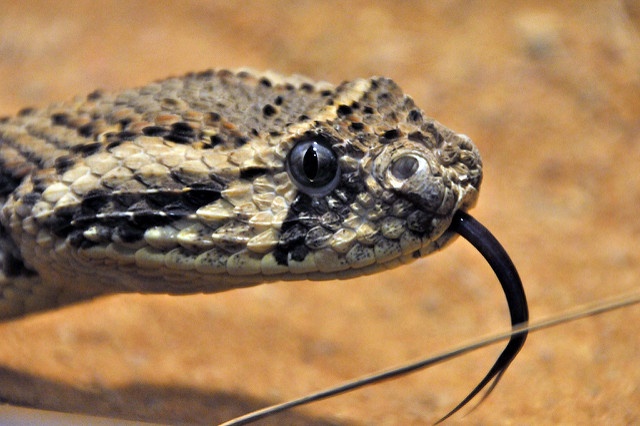Puff adder sticks out its tongue to lure a frog
A South African frog that perceives and approaches a tasty worm may be deceived. The worm may turn out to be the tongue of a snake, as Xavier Glaudas and Graham Alexander write, and if it is, the frog is in trouble.
The venomous puff adder (Bitis arietans), which lives in South Africa, hunts its prey by lying in ambush. Mostly nocturnal, camouflaged and hidden in the vegetation, it waits unobtrusively until a victim comes close, and then it strikes. But the striking range is only ten centimetres, so a prey often will stay out of reach.
Luring prey
But the snake uses a trick, Xavier Glaudas and Graham Alexander noticed when they reviewed a large amount of video recordings they had made of puff adders in ambush in the field. A puff adder often lures a prey by extending and moving the black tongue, the two points spread. The tongue then looks like a squirming worm and apparently, a frog is easily deceived. It hops closer to inspect the snack, and as soon as it comes within striking range, the snake will try to seize it. The frog that thought to find a meal is eaten himself.
Is the puff adder really mimicking a worm by extending the tongue to lure prey? According to the researchers, it does. The snake only extends its tongue if there is a frog or a toad close by, they argue; it doesn’t upon perceiving the presence of other prey, such as a mouse that doesn’t eat worms. Also, snakes use their tongues to sample odours, but chemosensory tongue flicks only take half a second while ‘lingual luring’ bouts take much more time.
The puff adders also wave their tails, and according to Glauda and Alexander that behaviour is also performed to lure prey. But they don’t have any recordings to show this, because their camera had been focussed on the heads of the animals.
Willy van Strien
Photo: Joachim S. Müller (via Flickr, Creative Commons CC BY-NC-SA 2.0
Xavier Glaudas explains his research
Source:
Glaudas, X. & G. J. Alexander, 2017. A lure at both ends: aggressive visual mimicry signals and prey-specific luring behaviour in an ambush-foraging snake. Behavioral Ecology and Sociobiology 71:2. Doi: 10.1007/s00265-016-2244-6
